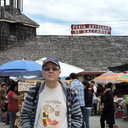Dietary patterns and risk of cancer of the oral cavity and pharynx in Uruguay.
Клучни зборови
Апстракт
From 1995 to 2002, a case-control study on food groups and risk of cancer of the oral cavity and pharynx was conducted in Montevideo, Uruguay. Two hundred thirty cases were frequency-matched to 460 controls on age, residence, and urban/rural status. The study was restricted to men. The relationship between foods and risk of oral and pharyngeal squamous cell carcinoma was examined through: 1) individual food group analysis, 2) factor analysis, and 3) determination of empirical scores. The results were similar. Factor analysis generated 2 patterns, which were labeled as "stew" and "vegetables and fruits." The stew pattern loaded positively on boiled meat, cooked vegetables, potato, and sweet potato. This pattern was directly associated with risk of oral and pharyngeal cancer [odds ratio (OR), 3.75; 95% confidence interval (CI), 1.99-7.06; P value for trend=0.0002]. The vegetables and fruits factor loaded positively on raw vegetables, citrus fruits, other fruits, liver, fish, and desserts. This pattern was inversely associated with risk of oropharyngeal carcinoma (OR, 0.34; 95% CI, 0.18-0.64; P value for trend=0.0008). Joint effects of high intake of risk foods and low intake of protective foods were associated with a risk of 12.0 (95% CI, 4.1-34.6). Our study confirms the important role of dietary factors in oral and pharyngeal cancer risk and suggests that the analysis of dietary patterns is a powerful tool to investigate the links between nutrition and cancer.





